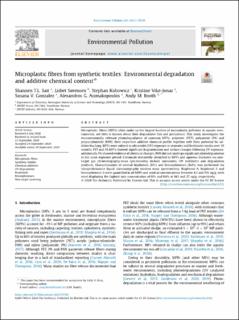| dc.contributor.author | Sait, Shannen | |
| dc.contributor.author | Sørensen, Lisbet | |
| dc.contributor.author | Kubowicz, Stephan | |
| dc.contributor.author | Vike-Jonas, Kristine | |
| dc.contributor.author | Gonzales, Susana Villa | |
| dc.contributor.author | Asimakopoulos, Alexandros | |
| dc.contributor.author | Booth, Andy | |
| dc.date.accessioned | 2021-02-19T09:25:19Z | |
| dc.date.available | 2021-02-19T09:25:19Z | |
| dc.date.created | 2020-09-25T13:25:07Z | |
| dc.date.issued | 2021 | |
| dc.identifier.citation | Environmental Pollution. 2021, 268 (Part B), . | en_US |
| dc.identifier.issn | 1566-0745 | |
| dc.identifier.uri | https://hdl.handle.net/11250/2729106 | |
| dc.description.abstract | Microplastic fibres (MPFs) often make up the largest fraction of microplastic pollution in aquatic environments, yet little is known about their degradative fate and persistence. This study investigates the environmentally relevant photodegradation of common MPFs: polyester (PET), polyamide (PA) and polyacrylonitrile (PAN), their respective additive chemical profile, together with their potential for additive leaching. MPFs were subject to ultraviolet (UV) exposure in seawater and freshwater media over 10 months. PET and PA MPFs showed significant fragmentation and surface changes following UV exposure, additionally PA showed evidence of chemical changes. PAN did not undergo significant photodegradation in the same exposure period. Chemicals tentatively identified in MPFs and aqueous leachates via non-target gas chromatography-mass spectrometry include monomers, UV stabilisers and degradation products. Characterisation of several bisphenols (BPs) and benzophenones (BzPs) was performed via ultraperformance liquid chromatography tandem mass spectrometry. Bisphenol A, bisphenol S and benzophenone-3 were quantified in all MPFs and wool at concentrations between 4.3 - 501 ng/g, with wool displaying the highest sum concentration of BPs and BzPs at 863 and 27 ng/g, respectively. | en_US |
| dc.language.iso | eng | en_US |
| dc.publisher | Elsevier | en_US |
| dc.rights | Navngivelse 4.0 Internasjonal | * |
| dc.rights.uri | http://creativecommons.org/licenses/by/4.0/deed.no | * |
| dc.subject | Miljøkjemi | en_US |
| dc.subject | Environmental chemistry | en_US |
| dc.title | Microplastic fibres from synthetic textiles: Environmental degradation and additive chemical content | en_US |
| dc.type | Peer reviewed | en_US |
| dc.type | Journal article | en_US |
| dc.description.version | publishedVersion | en_US |
| dc.subject.nsi | VDP::Miljøkjemi, naturmiljøkjemi: 446 | en_US |
| dc.subject.nsi | VDP::Environmental chemistry, natural environmental chemistry: 446 | en_US |
| dc.subject.nsi | VDP::Miljøkjemi, naturmiljøkjemi: 446 | en_US |
| dc.subject.nsi | VDP::Environmental chemistry, natural environmental chemistry: 446 | en_US |
| dc.source.volume | 268 | en_US |
| dc.source.journal | Environmental Pollution | en_US |
| dc.source.issue | Part B | en_US |
| dc.identifier.doi | https://doi.org/10.1016/j.envpol.2020.115745 | |
| dc.identifier.cristin | 1833474 | |
| dc.relation.project | Norges forskningsråd: 268404 | en_US |
| dc.description.localcode | This is an open access article distributed under the terms of the Creative Commons CC-BY license, which permits unrestricted use, distribution, and reproduction in any medium, provided the original work is properly cited. | en_US |
| dc.source.articlenumber | 115745 | en_US |
| cristin.ispublished | true | |
| cristin.fulltext | original | |
| cristin.qualitycode | 1 | |

